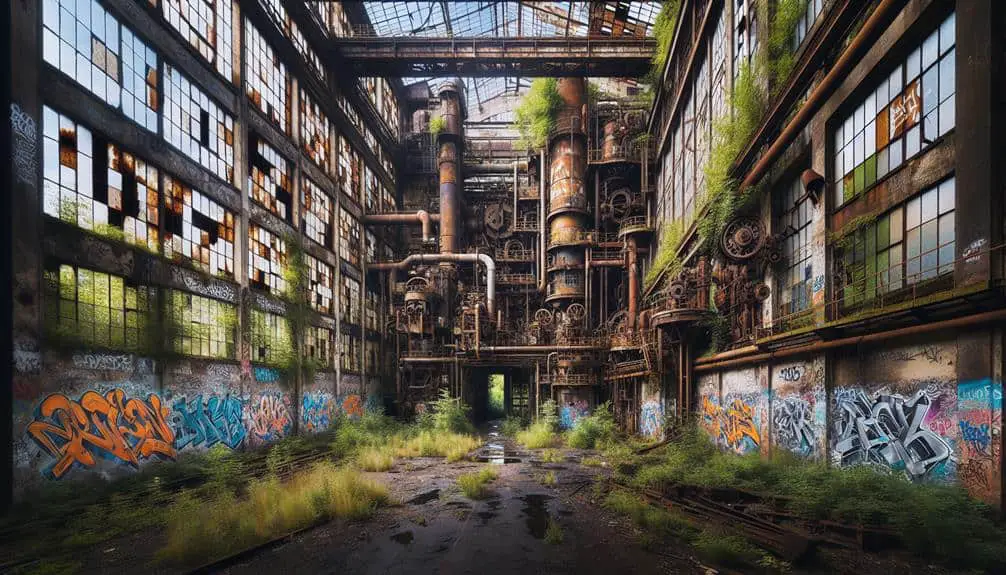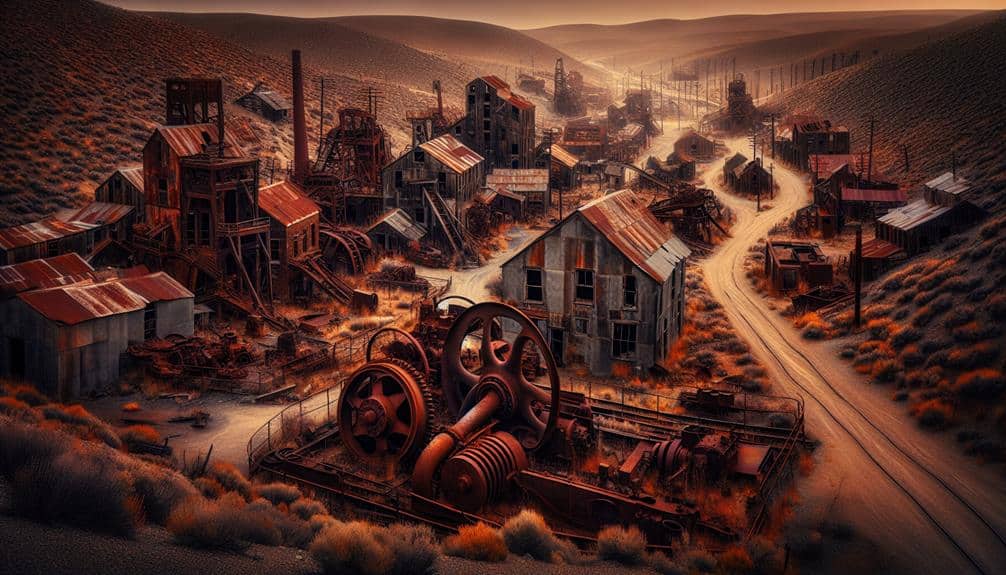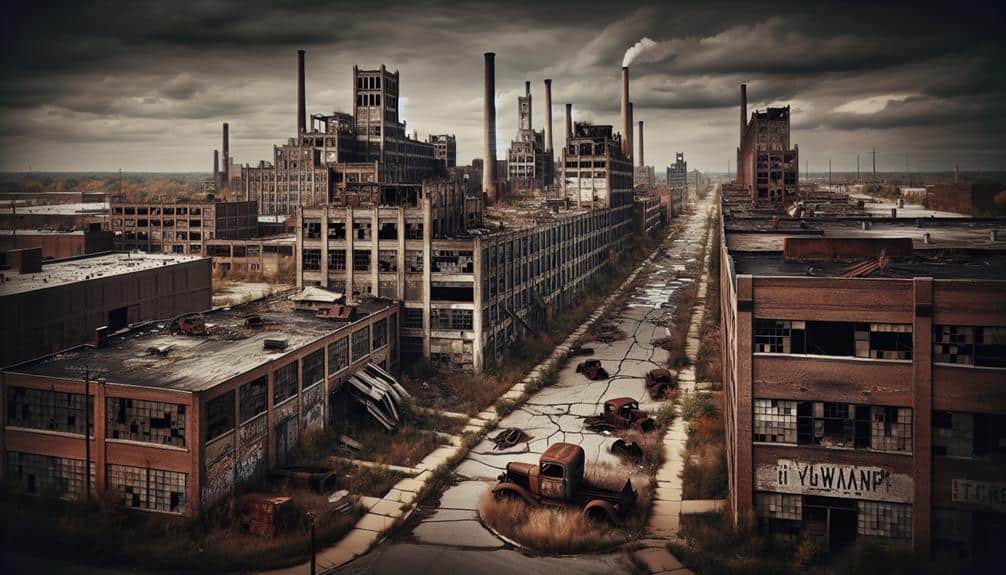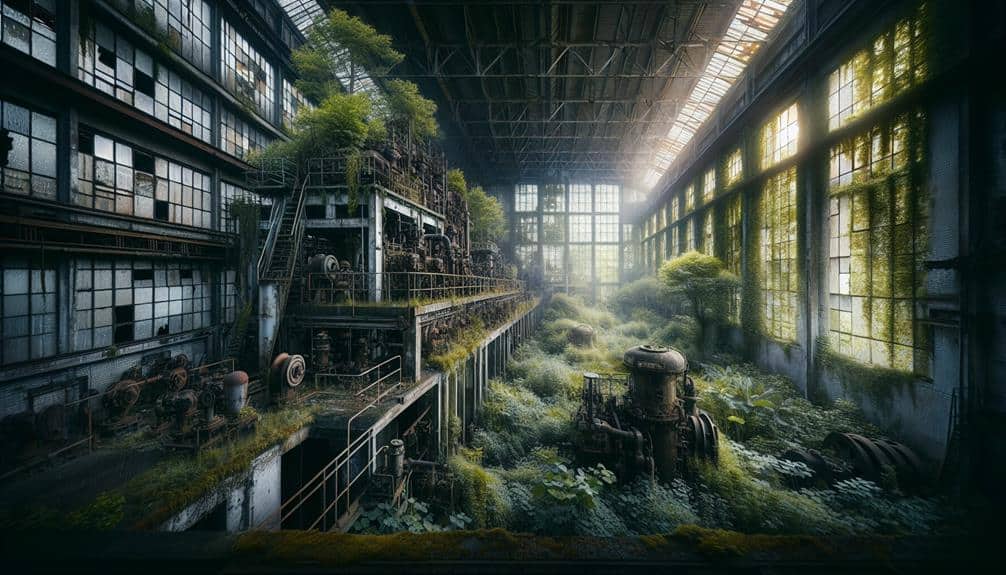To preserve America's historic industrial boom towns, blend preservation with adaptive reuse. Revive these communities by conserving their rich legacy. Embrace the intricate cycle of prosperity and decline that shaped these towns. Explore forgotten mining towns to grasp their historical importance. Revitalize industrial heritage through strategic projects. Consider transforming abandoned settlements into living museums. Honoring history paves the way for renewal and growth in these historic areas.
Key Points
- Implement preservation and adaptive reuse initiatives.
- Blend history with urban renewal for revitalization.
- Balance conservation with modern repurposing strategies.
- Transform ghost towns into living museums or modern spaces.
- Utilize technology like virtual reality for immersive experiences.
Rise of Industrial Powerhouses
During America's rapid industrialization in the late 19th century, the rise of industrial powerhouses reshaped the economic landscape of the nation. Industrial innovation surged, with advancements in steel production, railroads, and manufacturing processes revolutionizing the way goods were produced and transported. This period marked a significant shift towards mass production and increased efficiency, driving economic growth and transforming the United States into a global industrial leader.
The economic impact of these industrial powerhouses was profound. Jobs were created on a massive scale, drawing people from rural areas to urban centers in search of employment opportunities. This migration fueled urbanization and led to the development of bustling industrial cities. The expansion of industries such as steel, oil, and textiles not only generated wealth for a select few but also laid the foundation for the country's overall economic prosperity.
The rise of these industrial giants laid the groundwork for the modern American economy, setting the stage for further innovation and growth in the decades to come.
The Boom and Bust Cycle
In the domain of industrial history, the Boom and Bust Cycle unfolds as a complex interplay of prosperity and decline, shaping the trajectory of economic landscapes. These cycles are intrinsic to the evolution of industrial boom towns, characterized by rapid economic transformations followed by periods of urban decay. During the boom phase, bustling factories, flourishing businesses, and a surge in population contribute to a thriving community. However, the subsequent bust phase brings about a stark contrast as industries collapse, businesses shutter, and unemployment rises, leading to the abandonment of once-vibrant urban areas.
The Boom and Bust Cycle is a vital phenomenon in the life cycle of industrial towns, reflecting the ebb and flow of economic fortunes. Understanding this cycle is essential for preserving America's historic industrial boom towns, as it provides insights into the factors that contribute to their rise and fall. By recognizing the patterns of economic transformations and urban decay, efforts can be directed towards sustainable revitalization strategies that honor the past while fostering future growth.
Forgotten Mining Towns
As industrial landscapes weathered the tumultuous Boom and Bust Cycle, the echoes of forgotten mining towns reverberate through the annals of American history, silently bearing witness to the rise and fall of once-thriving communities. These abandoned ruins hold a deep historical significance, reflecting the grit and determination of early American settlers who carved out a living from the land. The remnants of old mining structures, ghostly and haunting in their decay, serve as a stark reminder of the transient nature of prosperity.
Walking through these forgotten mining towns, you can almost hear the clinking of pickaxes and the rumble of ore-filled carts that once filled the now-silent streets. Each crumbling building tells a story of boom times and eventual decline, a cautionary tale of the impermanence of economic fortune. It's in these desolate landscapes that you can truly appreciate the resilience of the human spirit, as communities once bustling with life now stand as testimonies to the passage of time and the fleeting nature of success.
Revitalizing Industrial Heritage
To rejuvenate the industrial heritage of America's historic boom towns, a strategic blend of preservation efforts and adaptive reuse initiatives is imperative. Reclaiming landscapes that once fueled the nation's industrial revolution is a noble endeavor that requires a thoughtful approach. Urban renewal projects can breathe new life into these once-thriving communities, preserving their history while creating opportunities for growth and revitalization.
Preserving Americas Ghost Towns
Preserve America's Ghost Towns by implementing innovative strategies that honor their history while fostering opportunities for renewal and preservation. Abandoned settlements hold a unique charm, offering a glimpse into the past and serving as a reminder of bygone eras. Preservation efforts for these ghost towns are vital in maintaining their historical significance and preventing them from fading away entirely.
To effectively preserve America's ghost towns, it's essential to strike a balance between conserving their original state and allowing for adaptive reuse. By engaging local communities and historical preservation organizations, these settlements can be transformed into living museums or repurposed for modern uses while still honoring their heritage.
Furthermore, leveraging technology such as virtual reality and augmented reality can provide immersive experiences for visitors, allowing them to explore the ghost towns virtually and learn about their rich history even if they're physically inaccessible. By embracing creativity and collaboration, abandoned settlements can be revitalized while safeguarding their legacy for future generations.
Frequently Asked Questions
How Can Local Communities and Organizations Work Together to Preserve the Historic Industrial Boom Towns?
To conserve historic industrial boom towns, you can cultivate community partnerships by pooling resources and expertise. Collaborate on preservation efforts like restoring old buildings or creating heritage trails. Together, you can guarantee these towns' legacies endure.
What Are Some Challenges Faced When Trying to Revitalize Industrial Heritage Sites in Modern Times?
Revitalizing industrial heritage sites in modern times poses challenges like balancing economic development with historical preservation. Community engagement is essential to navigate these complexities, ensuring sustainable growth while honoring the past.
Are There Any Specific Industries That Are More Commonly Associated With the Boom and Bust Cycle in Historic Industrial Towns?
In historic industrial towns, the mining industry often exemplifies the boom and bust cycle. Economic downturns can decimate mining communities, leaving behind abandoned mines and struggling populations. Understanding this pattern is essential for revitalization efforts.
How Do Environmental Factors Play a Role in the Preservation of America's Historic Industrial Boom Towns?
In preserving America's historic industrial boom towns, environmental factors like pollution influence conservation efforts. Understanding the role of pollution in these towns helps shape strategies for sustainable development, heritage preservation, and community well-being.
What Are Some Unique Ways That Technology and Innovation Are Being Used to Help Preserve the Heritage of These Towns?
Explore how technology like virtual tours and augmented reality are revolutionizing heritage preservation in America's historic industrial boom towns. These innovative tools bring the past to life, making history accessible and engaging.



